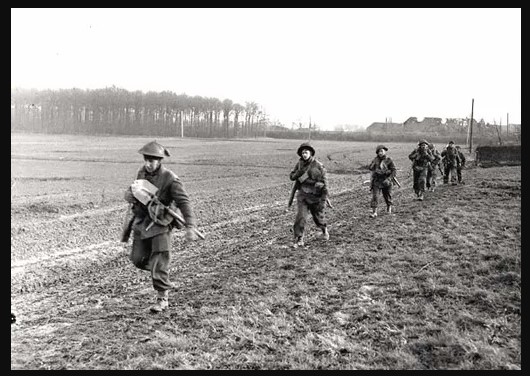It’s been a century since Niagara-on-the-Lake’s iconic clock tower cenotaph was erected. Then, in 1926, the Township of Niagara unveiled its own memorial in Queenston. In recognition of those who fought and died in two world wars and beyond, NOTL historian Ron Dale has been researching the stories of the people – all men – whose names are engraved on the two cenotaphs. This is one in a series of stories documenting and remembering the sacrifices of those commemorated on the municipal memorial in Queenston.
Ron Dale
Special to The Lake Report
The Battle of Normandy or Operation Overlord, which began with the Allied invasion on D-Day, June 6, 1944, ended on Aug. 30 when German forces had finally been driven across the Seine River in France.
The Algonquin Regiment, part of the 4th Canadian Armoured Division, landed in France on July 23 and 24 to take part in the final phases of Operation Overlord.
The regiment fought in Operation Totalize, Aug. 8 to 13, and Operation Tractable, Aug. 14 to 21.
Both battles were attempts to cut off a German retreat, catch them in a pincer movement in conjunction with U.S. forces and force their defeat in what was known as the Falaise gap.
These advances were partially successful. The Falaise gap was closed by Aug. 21 and, while several German units were able to continue their retreat, others were annihilated or forced to surrender.
The next phase of the Allied advance was to drive to the Seine and prepare to attack German forces behind strong defences on the far side of that major river.
The British Second Army crossed and breached the German defensive positions on the Seine. The Germans continued to retreat, while fiercely resisting the Allied advance.
The 4th Canadian Armoured Division, including the Algonquin Regiment, was charged with advancing on the western flank of the Allied forces along the coast of France, Belgium and the Netherlands.
Their goal was to reach Antwerp in this phase of the war. The Leopold Canal on the Dutch-Belgian border represented a major obstacle to this advance. The Algonquin Regiment was ordered to clear the areas west of the canal.
On reaching the canal at the village of Moerkerke, the Algonquins were ordered to cross the Leopold and adjacent Canal de Dérivation de la Lys in boats ferried by the men of the Lincoln and Welland Regiment.
The goal was to overwhelm German defences and establish a bridgehead for the rest of the 4th Armoured Division to cross.
The attack on Sept. 13 and 14 was a shambles. The men were mowed down by German artillery and machine-gun fire. Ultimately, they were forced to abandon the attempt.
In this failed attack, the Algonquins lost 153 men. Among them was Cpl. Frederick Ward of Niagara Township.
Fred Ward was born in the town of Beamish in Suffolk, England, on Feb. 24, 1908, one of the eight children of Thomas Ward and Frances Louisa Mills. Thomas was a veteran of the British Army in the First World War.
The family emigrated to Canada when Fred was 13, arriving in April 1921. They settled on Niagara Stone Road in what is now Niagara-on-the-Lake.
He took an interest in technology and trained as an auto mechanic and welder.
During the Second World War, four of the Ward boys enlisted. Thomas, John George and Fred joined the Canadian Army overseas while their youngest brother Edward joined the RCAF.
Fred signed up with the 2nd/10th Dragoons in Hamilton on July 11 and underwent training for the next year and seven months.
He was promoted to acting lance corporal at Camp Niagara within six weeks of enlisting. He was then sent to the Canadian camp at Debert, N.S., and promoted to corporal in November.
In addition to standard infantry training on rifles, machine-guns, grenades and mortars, he was certified to drive a variety of military vehicles.
Ward was transferred from the Royal Canadian Dragoons to the Canadian Infantry Reinforcement Unit and shipped out to England, disembarking on Feb. 24, 1944.
In England, his training intensified as the Allies prepared for the invasion of France.
On July 23, 1944, he was sent to Normandy, destined to join the Algonquin Regiment as a reinforcement. He reached the regiment in the field on Aug. 9 in time to participate in Operation Totalize and Operation Tractable.
He was among the Algonquin Regiment men who assaulted German positions on Sept. 13 and 14, but was among those killed in that bloody assault.
He was buried near his place of death until his body could be recovered later and reinterred in the Adegem Canadian Military Cemetery in Belgium. His sacrifice is remembered on the cenotaph in Queenston.










